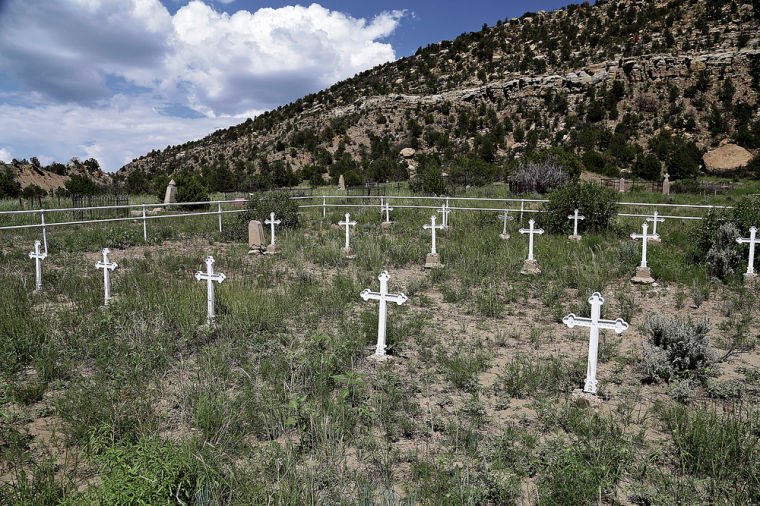In 1906, the mines were purchased by the Phelps Dodge Corporation. The corporation needed to attract workers to the remote location, so they built homes for the miners, along with numerous other facilities including a hospital, department store, swimming pool, movie theater, and a golf course.
With these amenities, Phelps Dodge was able to maintain a stable employment rate despite the inherent dangers of mining and the isolation of northern New Mexico. Many of the miners were recent immigrants. In total, the Dawson coal operations had ten mines, numbered 1 – 10 in the immediate vicinity of Dawson. The mines are generally referred to as “Stag Canyon #”, a reference to the operating company, but they are also often referred to as “Dawson Mine #”, in reference to their locale. Different web pages which use GNIS data have the Dawson Mine No. 5 as being located eight miles north of the other mines. In looking at other source documents found in Google Books, this appears to be an error. The actual Dawson Mine No. 5 was located along the Vermejo River, near the town of Lauretta.
Several of these mines were connected to the coal processing and loading facilities in Dawson by means of an electric powered narrow gauge (36 inch gauge) railroad. This railroad was apparently 6,600 feet in length, running along Rail Canyon from the entries of Mines 1, 2, 3, 4 and 6. Mines 5 and 7 also connected to this line through underground connections to the other mines, but they also had their own tipples. Cars would be loaded inside the mines, taken outside and then transported in trains of cars to the facilities in Dawson proper. This line served the No 1 & 2 Tipple, located in Rail Canyon.
Mines 8, 9 and 10 are located to the SW of the town of Dawson, and early research indicates that they had their own mine tipple for coal cleaning and loading into standard gauge railroad cars for delivery to customers. These three mines also had an electric powered railroad inside the mines which led to their own tipple, but they apparently were not connected to the other mines.
The coal was cleaned of non-combustible debris and sorted into general sizes for different uses. In addition to the coal processing facilities, there also were coking ovens which processed the coal, transforming it into coke which was used for metal processing by Phelps Dodge at other facilities.
The coking ovens produced carbon monoxide gas, which was captured and then burned to create steam for generating electricity for mine machinery and electric lighting, both in the mines and in the towns around the mines. The Dawson Railway was purchased by Phelps Dodge at the same time and made part of its El Paso and Southwestern Railroad system. The EP&SW was later purchased by the Southern Pacific Railroad, which also purchased long term contracts for the coal production from Dawson. The SP used steam locomotives which were mostly fueled by oil, but the operating division located at Tucumcari utilized coal fueled steam engines, the only group of such locomotives on their roster.
MINERS BURIED ALIVE
RESCUE PARTIES RUSH WORK CLEARING DEBRIS.
FORMER MINE EXPLOSION AT DAWSON, N. M., CAUSED THE DEATH
OF 263 MEN.Dawson, N. M. – A terrific explosion that rocked the workings of coal mine No. 1 of the Phelps-Dodge Corporation here entombed 122 miners working inside.
The explosion occurred at 2:30 o’clock in the afternoon and tore away all of the heavy concrete work at the mouth of the mine entry. Within a short time after the blast rescue workers had cleared the debris from the mouth of the mine and a rescue crew, led by W. D. Brennan, general manager of the mine, entered. The imprisoned miners were about 5,000 feet from the portal of the mine.
The cause of the explosion is a mystery. A statement by the company declared the mine was well sprinkled and was not gaseous. The explosion did not wreck the mine fan and ventilation soon was established.
The explosion was the second in Phelps-Dodge property here, a similar accident in mine No. 2 wiping out 263 lives in 1913. While company workers who volunteered for rescue duty were continuing their efforts the United States bureau of miners started a rescue car here from Hanna, Wyo., and a second car sent by the Colorado Fuel and Iron Company was sent from Trinidad.
Almost before the reverberation from the explosion ended, scored of women and children, members of the families of the miners, run to the mouth of the property. Weeping for their loved ones inside they pressed forward about the cordon of guards formed in front of the mouth of the mine. The guards kept them back so that the work of rescue parties would not be hampered.The loss of life may be large, although the usual precautionary measures taking in the mining operations will undoubtedly result in saving those in the inner workings of the soft coal mine beyond the immediate field of the explosion. The mine is one of the largest operated by the company at Dawson and was previously the scene of a subterranean tomb as the aftermath of the blast.
For more that a week recue [sic] crews braved the dangers of falling debris, fire, and gas, before the last bodies of the miners killed in the blast and fire were recovered. Officials at the time were unable to account for the disastrous explosion in the Stag canon mine No. 2, but officials , following the accident, declared it was their beliefs that a miner, with an open lamp had encountered an unknown pocket filled with gas, which was exploded, wrecking the mine.
Dawson is one of the largest coal mining camps in the United States. Four mines are operated at that place, the total population of the comp numbering about 5,000.
